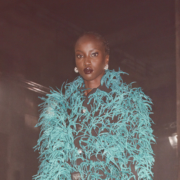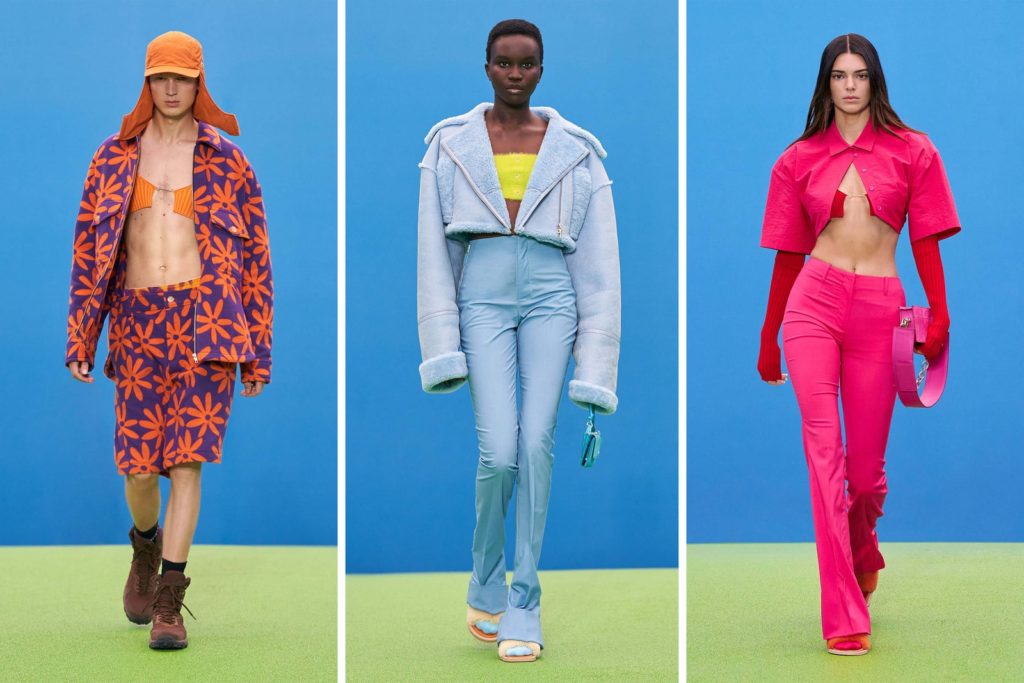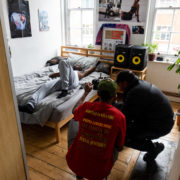Dopamine Dressing: Can You Dress Yourself Happy?

By Charlie Elizabeth Culverhouse
What people wear reflects how they feel, or want to feel, and this varies from person to person on a vast scale. But in times of collective tragedy, clothing goes beyond looks, goes beyond personal emotion, and becomes a depiction of society’s collective feelings.
The way the most recent collective tragedy, and subsequently the collective societal emotion, has manifested comes in the form of escapism. Just as we saw in both the post-war era of the 1920’s and the era of Restoration England (after the not-so-jolly Oliver Cromwell and his drab rules restricting dress were demolished), the post-pandemic (well, as post-pandemic as we can hope for) world has led to a more joyful, colourful and expressive way of dressing.
After the dreadful, still almost unimaginable, year we’ve all had, getting dressed up in bright and colourful clothes for any reason at all is a welcome distraction from the gloomy feelings we harbour. We want to escape from the harsh realities of society and clothing is – as it always has been – the easiest way to do this.
Before the pandemic, catwalks were ripe with political and societal ‘hot takes’. Fashion has been rightfully promoting the injustices of the world, but seeing the lack of joy in people’s lives, and knowing fashion’s ability to inspire, the catwalk has taken a turn to better bring joy to the lives of fashion lovers. It’s no argument that the issues which inspired the hard hitting looks are still rampant today in society and it’s also no argument that fashion is a great way to call people into action and promote activism. But with no end in sight, and with the collective world-mood being so low, people want to turn to fashion as an escape from the feeling of impending doom rather than turning to it for a reminder of wrong doings.
This is exactly why escapist fashion has become all the rage. Throughout the pandemic we had Bridgerton encouraging us all to picnic, drink tea, and pretend we lived in an era prior to this political and societal damage. Would we all have been so invested in this fantastical life if we weren’t shut up in our homes climbing up the walls a little? We also had the rise of aesthetics like Royalcore and Cottagecore, any phenomenon that welcomed us into a world (albeit a fake world), was a glimmer of escapism that those hit by the pandemic ran to with all their might. The escapism was fun and as we transition back into ‘normal life’ we want to keep some of that fun, some of that reality-bending narrative. We need a more wearable, somewhat toned down version to liven up our day-to-day lives.
This is where dopamine dressing steps in to solve our fashion woes. Dopamine dressing promotes the idea that wearing certain clothes can elevate your mood. It’s more of an anecdotal fashion legend than it is backed by science. But while there isn’t any hard evidence, common sense places the idea in at least the realm of ‘it’s worth trying’ right?

Dopamine dressing is an inherently fluid pursuit and works to an individual’s preference. Someone who likes the colour green will feel good in green, someone who hates the colour green probably won’t feel comfortable in a furry lime coat. The theory encourages people to find what makes them feel good and wear it for themselves and for their own happiness – who cares if you’re just popping to the shops, dress a little fancy, get on that outfit you’d been saving for a special occasion! You don’t need a reason to dress up, you feeling good is reason enough.
We often find that we save the clothes that make us feel the best for our best occasions. There is a lot wrong with this mindset. While it is nice to feel extra special on those rare occasions we’re invited to a dazzling event, wouldn’t it be even nicer to feel that good all the time? Our ‘best’ clothes are usually the ones we’ve spent the most money on so we want to save them, why not get your money’s worth by wearing it all the time and feeling good all the time? You’ve forked out some serious cash for it, why just wear it a couple times in your life? And of course you have the age-old, undebatable reasoning to back up dopamine dressing: someone asks why you’re so dressed up, ‘why not?’, how come you’re wearing a ballgown in the supermarket? ‘Because I can!’ – there is nothing stopping you from wearing what you want.
You may think that going out all dressed up might make you feel out of place or self-conscious. Maybe you’re too shy to go out in all your escapist glory. While there is nothing forcing you to do anything you’re uncomfortable with, going out dressed as you wish to be dressed gives you the tools to be exactly who you want to be. Your clothes will give you confidence (again not completely backed up by science). If you feel your best then you’ll be your best!

While it is widely reported that those who favour dopamine dressing extol the theory that wearing brighter colours and bolder patterns can elevate your mood, this is simplifying the idea a little too much. Dopamine dressing doesn’t necessarily need to be about bright colour or extravagant pattern or fur trim. All it is about is wearing the textures, patterns, colours, hues, pieces that make you feel good. That could be big, knit jumpers, comfy joggers or a mesh mini dress – it doesn’t matter! It can also be a certain colour or a specific outfit that you had a great experience in. It could be something brand new that you found at the thrift store and can’t wait to show off or it could be a top that reminds you of good times!
The dopamine dressing movement revolves around you, there’s no wrong or right. Feelings are subjective. For some, wearing all black could instil more happiness than walking around in a monochrome yellow look. An individual’s personal associations with particular clothing will impact how they feel in an outfit.
It is here where we present the only scientific evidence backing up this theory; the wearing of an item and the wearer’s belief in the symbolic meaning of that item, can have an effect on their cognitive processes, and part of those processes are emotions. For example, one study put participants in a garment. To one group they called this garment a ‘doctor’s coat’, and to the other group, the identical garment was labelled a ‘painter’s coat’. Those in the ‘doctor’s coat’ performed better in a given task than those in the ‘painter’s coat’ – even though the coat’s were the same and had no influence on the task at all. The study suggested that a person’s belief in their clothes will affect their confidence and their ability – you have to have a belief in the item you’re wearing for it to boost your mood. Lucky socks are starting to make more sense now huh?

You would be forgiven for thinking that dopamine dressing was simply attributable to summer looks, but going into the colder months, dopamine dressing isn’t going anywhere. The 2021/22 autumn/winter catwalks were full of bold, bright colours and busy patterns covering interesting silhouettes. Dopamine dressing worked perfectly alongside many popular spring/summer trends popularised by TikTok this year; Y2K, CoconutGirl and Kidcore (featuring plastic jewellery and toy-like accessories) being just a few.
But it does appear that the ‘happy clothes’ theory will continue to impact the traditionally darker autumnal fashion and continue to have an effect through the coming years. Luxury brands like Jacquemus and Bottega Veneta are growing in popularity thanks to dopamine dressing, and it’s no coincidence that smaller brands, such as House Of Sunny, are doing so well in this search for happiness through clothes.
In times when the world is anything but playful, fashion steps in to fill the void. Since being let back outside, our literal freedom has woken us up to our personal freedom and autonomy which we perhaps took for granted before. Dopamine dressing is about seizing the moment and owning it. We don’t need to waste time fitting in a box. So get your happy clothes on, dress outrageously – go out there and really be seen.
Discover more from GUAP’s Fashion section here

